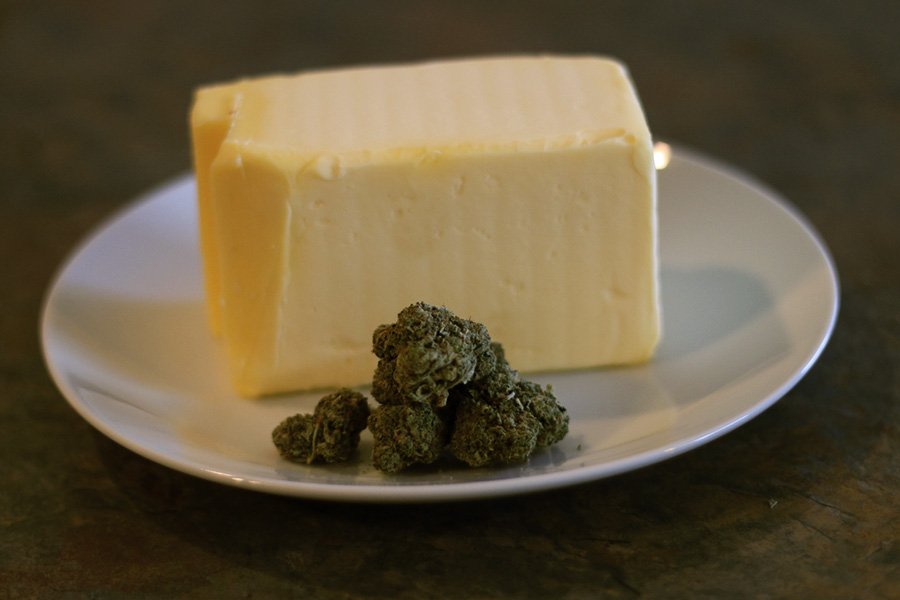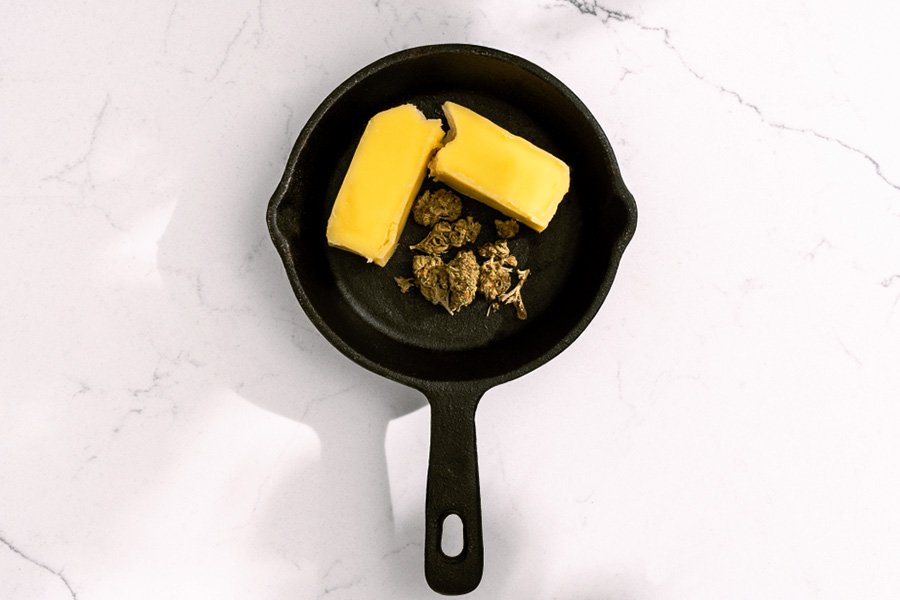Cannabutter Ratio Calculator
It is difficult to determine the cannabutter's potency, even for professionals in this industry. But with a cannabutter ratio calculator, anyone can evaluate how much THC or CBD compounds are needed in certain cannabis products.
Cannabis is legal in many states across America and Canada. Due to this, there is an evident increase in the use of homemade and dispensary-bought marijuana-infused products for both medicinal and recreational purposes.
However, many find it confusing to decide how much THC or CBD should be ingested to achieve desired results.
Source: shutterstock.com / Photo Contributor: SingingMedia
Cannabutter Ratio Calculator - A Precision Tool
Cannabutter is made of cannabis and cooking butter to create baked goods such as edibles. It can contain cannabinoid compounds like THC and CBD, depending on the effect you want to achieve.
A cannabutter ratio calculator allows for an easy determination of the butter-to-cannabis ratio needed to make edibles. This precision tool can also help make the cannabis products as potent as you need, depending on your individual preference.
As with many types of equipment we have used, the potency calculator is not a difficult tool to navigate. Simply enter the amount of cannabis ingredients and the number of servings you wish to produce. Then, the dosage calculator will do the job for you.
The cannabutter ratio calculator accounts for potency and weight. Thus, you can easily customize it based on your personal needs. This tool is available online, perfect for both beginner users and long-time enthusiasts to ensure safe and effective edible dosage.
How to Use the Cannabutter Ratio Calculator
When measuring the potency of edibles, it’s important to consider both THC and CBD content. If the cannabinoid content is higher, the potency of the edible goes up.
To figure out how much cannabis is in an edible, we advise using a Cannabutter Ratio Calculator. With this tool, the edibles’ potency is measured in milligrams (mg). Below, we explain the easiest way of measuring the cannabis ratio in a product
Results:
Step-by-Step Guide for Accurate Calculations
Before calculating the dosage, you must determine the concentration of THC or CBD in the flower. You must also discover the weight of your flower bud, which will help you calculate the amount of mg of THC or CBD in your edibles.
Then, you’ll need to find out the volume of your infusion liquid. When you have all these measurements ready, you will be able to write the quantities into the cannabutter ratio calculator and determine the potency of your cannabis-infused products.
For example, seven grams of cannabis have 25% THC potency. If you infuse it with 2 cups of liquid, you will have around 1750 mg of THC or approximately 18 mg of THC per teaspoon.
Cannabis Weight
To determine the weight of your cannabis, you may need to do some math. Don’t be intimidated; it’s a very simple process involving only a few steps:
Determine the number of grams of cannabis flower used to make cannabutter
Multiply that number by 1,000 to convert the measurement to milligrams
Multiply the weight of the flower in milligrams by its percentage of THC
Get the total number of cannabis milligrams in the entire batch of butter
Desired Dosage
If you are a long-time cannabis user, you are likely familiar with your THC tolerance. For example, if you usually smoke a certain amount of cannabis, you will get similar effects by consuming the equivalent amount of edibles.
However, all cannabis products don’t offer the same effects. This variability may depend on the edibles’ quality, potency, and strain. For this reason, the desired dosage of most cannabis users reaches no more than 5mg of THC per edible.
If you are a beginner to edible consumption, start with a lower dose or 2 mg of THC per edible. Controlling your dosage this way will help you determine your tolerance and prevent you from overdoing it.
Butter Quantity
We usually put a lot of emphasis on quality when talking about ideal ratios in cannabutter used for making edibles. But the value of THC quantity also comes into play to ensure proper dosing and potency control of the cannabis products.
You can determine how much butter you need in your edibles by following a simple formula: one pound of unsalted butter is added to every seven grams of decarboxylated, ground cannabis
Calculating Cannabutter Ratios for Recipes
Cannabutter is a versatile ingredient that can be easily implemented in numerous recipes. But many people wonder how much of it is needed to provide a solid experience and feel the desirable effects of cannabis.
You can calculate how many milligrams a homemade butter has before you use it in your recipes. There is an example of using 28 grams of cannabis that tested at 10% THC to make one cup of butter. This resulted in 2800 milligrams of THC in that one cup of butter.
But, the number of milligrams you use for edibles may vary depending on the amount of butter listed in your recipe.
Source: shutterstock.com / Photo Contributor: mynewturtle
Tailoring Ratios for Specific Culinary Creations
Some recipes call for a butter amount that may make the edibles too strong. Luckily, you can tailor the ratio for specific culinary creations by using a cannabutter ratio calculator. This way, you will get control over the potency and dosage.
For example, if you are following a recipe that requires 1/2 cup of butter to make ten brownies, the whole batch will have 1400 mg THC. Divide this number of milligrams by the number of servings to find how much THC each brownie will contain. If the listed cannabutter ratio is too strong for you, mix it with plain butter for less potent effects.
Examples of Calculated Ratios for Ropular Dishes
In addition to the classic pot brownies, chocolate weed cookies are a popular recipe among cannabis users. In cases where the sampled butter results in a stronger dose, it can always be diluted with regular butter.
To make cannabis cookies with chocolate chips, you will need:
An egg
100g sugar
2g salt
5g vanilla extract
185g flour
2g baking soda
225g chocolate chips
115g of cannabutter
Mix the dry and wet ingredients in separate bowls. Then, add the wet to the dry ingredients and add the chocolate at the end. Refrigerate for around two hours before baking to get the fluffiest texture. They will be done after 9-10 min at 350F in a preheated oven.
Note: This recipe is tailored to produce around 16 cookies, each dose containing approximately 7g of cannabutter, which can be a lot for some people. Thus, you can mix 15g of cannabutter with 100g of regular butter to get a balanced flavor and a more enjoyable experience.
Dosage Control and Personalization
Edibles differ from other cannabis products in several ways. The human body processes THC edibles through the digestive system. Thus, they create a more potent, long-lasting effect that can take a few hours to reach a peak.
Cannabis products like edibles can be tricky to dose because you don’t know how your body may react to them before ingesting. Also, the user’s weight, age, genetics, and gastrointestinal health may influence their response to edibles.
Achieving Customized Dosages with Calculated Ratios
For easy dosage, you can cut the cannabutter into small, uniform pieces. But, always ensure you start low and slow because you can always add more cannabutter or eat more edibles, but you can’t undo it.
Keep in mind that whenever you are cooking with cannabutter, you are dosing for the entire batch of edibles. For example, if you want to make 20 edibles, you will need to add 24 doses of cannabutter into the mixture.
Adjusting Ratios for Individual Tolerance and Preferences
A standardized dose for cannabutter doesn’t exist. But if you are new to edibles, one to five milligrams of THC is enough.
While 10 mg may be the average dose of THC in edibles, we advise you to start with a lower dosage.
Safe and Responsible Usage Guidelines
Dosing the amount of cannabutter in homemade edibles is a complex process. The THC potency in each batch may vary, depending on the type of cannabis and cooking techniques used during edible production.
If you make edibles at home, remember that the amount of cannabis used in the cannabutter gives it its THCA percentage. Legal markets selling edibles must have the THC potency per serving labeled on their packaging to improve consumers’ understanding of serving size.
To ensure safe and responsible usage, avoid combining cannabis edibles with alcohol or other opiates. Mixing various substances may lead to certain side effects, like enhanced feelings of euphoria or delusion.
Source: shutterstock.com / Photo Contributor: Agave Photo Studio
Conclusion
All homemade cannabis edibles are made with cannabutter. But, before ingesting any cannabis product, you must calculate how much THC or CBD is contained in a dose. The cannabutter ratio calculator is the perfect precision tool for this purpose.



